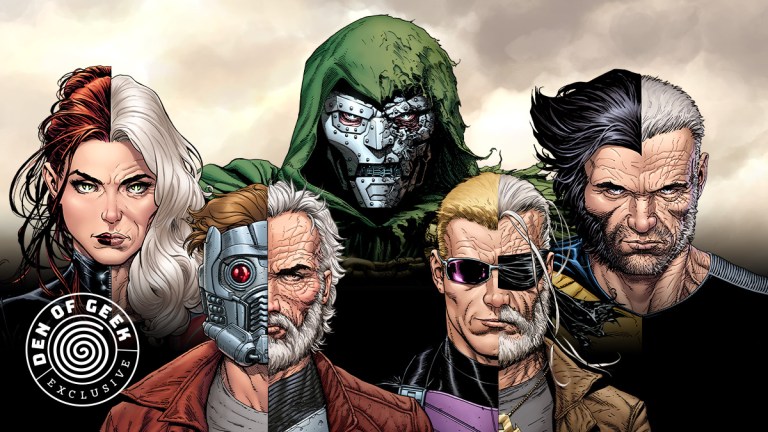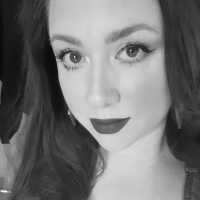How Marvel’s Wastelanders Podcast Created an Exciting Story with No Visual Safety Net
Marvel’s dystopian podcast Wastelanders assembles a handful of iconic superheroes for one last mission.

This article appears in the new issue of DEN OF GEEK magazine. Get your copy here.
Marvel comics are known for their stylish drawings, bold colors, and dynamic splash pages, and the Marvel Cinematic Universe has achieved incredible box office success utilizing expensive VFX, razor-sharp fight choreography, and a parade of recognizable faces. But how do you create a sprawling, action-packed Marvel project without using any of that? This was the challenge Marvel faced when it decided to develop a six-season scripted podcast featuring some of its most beloved superheroes and villains but in a surprising new context.
The denizens of Marvel’s Wastelanders are living in an alternate future Marvel timeline where the villains have ultimately won, and very few heroes have lived to tell the tale. In this new world order, Wolverine, Hawkeye, and Black Widow are scattered—either in hiding or as shadows of their former selves. When Star-Lord suddenly crashes back to Earth on a curious mission, a series of events forces them all to assemble one last time.
Jessica Jones and Supergirl TV writer J. Holtham’s background as a playwright helped him flesh out the aural world of Marvel when he first came aboard to pen Wastelanders: Hawkeye, the second in the interconnected series of podcasts.
“So much of theater is in the dialogue and conversation,” he tells Den of Geek magazine. “With a scripted podcast, there’s a lot more that you have to describe to the audience. You have to figure out how to make it okay for people to narrate what they’re doing. Pulling an arrow back in a bow might seem like a distinctive sound. It is not! Neither is shuffling cards. So we asked ourselves, ‘what are distinctive sounds, and how can we incorporate other things that are happening into the dialogue?’”
Similarly, Marvel Comics veteran Mark Waid tells us he was inspired by the storytelling of 1930s and ‘40s radio serials when writing Wastelanders: Doom. “My father introduced me to the old-time radio shows he loved as a kid, and I’m still a fan. Having listened to thousands of hours of shows like The Shadow and Inner Sanctum really trained me to write visually.”
But it’s the incredible voice talent who make the world of Wastelanders come alive in this format. The cast boasts the likes of Susan Sarandon, Robert Patrick, Sasha Lane, Dylan Baker, Stephen Lang, Keith David, and Chris Elliot. “Everyone wants to be a part of the Marvel Universe,” Holtham says. “It attracts a lot of people across all spectrums, and there are a lot of secret geeks out there!”
Wastelanders features a massive cast of characters, and the actors playing them had to understand that the action would incorporate not just their performance and various sound effects but the audience as an active participant.
“You don’t have to narrate every single punch, but you have to be able to communicate the physicality of a scene,” Holtham explains. “You can add your grunts and ‘oofs, but mostly it’s about getting these characters into a room so they can talk and letting the audience’s imagination fill in the scope, especially with the big action sequences.”
The first five seasons of the podcast focused on individual character journeys, but as those stories unfolded, a bigger picture emerged.
“When we started working, we were a bit siloed,” Holtham says. “We did have a couple of writer’s summits to agree on some basics, but when I built Hawkeye, I was given a fair amount of latitude [which] this world allows because it’s divided into sections, and each section can be very different from the other. Once we moved into the team-up aspect of Wastelanders, we were all pulled together, and it became a much more traditional, collective effort.”
This collective effort has led to a final team-up, gathering Wolverine, Black Widow, Hawkeye, and Star-Lord together to face the consequences of living long past their relevance. Nostalgia for an Earth with a protective stronghold of mighty heroes has faded. The future is dangerous, often lawless, and villainy is around every corner. The Old West is new again. What do our remaining Marvel heroes have left to fight for?
“These are broken people who have lived through an apocalypse and its aftermath, and they have done terrible things,” says Holtham. “They have lost everything they cared about and have to reckon with that. Wastelanders is a conversation about how to rebuild the world. Are you trying to build the world as it was before? Are you trying to build something new? For me, that’s always an interesting conversation. To do it with these characters makes it extra exciting.”
At 10 episodes, Wastelanders’ concluding team-up might be the longest Marvel climax in history, so it naturally stands apart from the kind of final act we’re used to seeing on the big screen—there aren’t a lot of prolonged, deep talks at the end of your average MCU film.
“The trickiest part has been to take all of these series that have had their own emotional arcs and their own stories and find a way to tie them all together,” says Holtham. “In that way, the slow burn helps.”
Marvel’s Wastelanders is available wherever you get your podcasts.
